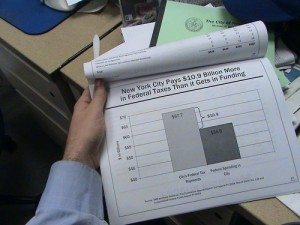 A friend of mine calls her journalism students “do-gooders who hate math.” But journalists need math skills to make sense of numbers the way they need language skills to make sense of words. The truth is, math is not rocket science and you don’t need to be a nerd to improve your reporting of news with numbers. You just need to remember one basic, journalistic question: “Does this make sense?”
A friend of mine calls her journalism students “do-gooders who hate math.” But journalists need math skills to make sense of numbers the way they need language skills to make sense of words. The truth is, math is not rocket science and you don’t need to be a nerd to improve your reporting of news with numbers. You just need to remember one basic, journalistic question: “Does this make sense?”
One of the most common mistakes when it comes to dealing with numbers is failing to make sure those numbers add up. This can lead to stories about polls which sampled more than 100 percent of respondents, or budgets that are larger than the sum of their parts. All it takes is a minute with a calculator to avoid these kinds of errors–and the “you people are stupid” calls they often generate.
Another frequent mistake journalists make is relying on raw numbers instead of calculating the relationship between those numbers to help people understand what they really mean. Yes, that means you have to do the math to determine percentages, and percent change, and rates [comparing numbers while holding a key variable, like population, constant]. But the good news is there are dozens of terrific online calculators to help you get the results right. Calculator.com is another good starting point.
You can’t always be online, though, so learn how to use the calculator on your smart phone or PDA, or carry a separate calculator with you. You’ll also want to have other resources at your fingertips. Ask your local university for the name of a good statistician–someone you can call when faced with a confusing number stories. Consider using an online forum, like Ask Dr. Math at Drexel University, for questions that may be less time-sensitive.
Other resources are available to improve your skills and boost your confidence in dealing with numbers. In “News by the Numbers,” writing coach Jack Hart details a series of essential steps every journalist needs to take when dealing with number-heavy stories. The IRE’s Sarah Cohen offers cheat sheets and tips in a collection of handouts, “Danger! Numbers in the Newsroom!”
Journalist Robert Niles has posted statistics every writer should know. Included are valuable tips on how to determine if the data you are looking at adds up to a story worth reporting. Another tipsheet by Kathleen Woodruff Wickham of the University of Mississippi, can help you understand the basics of polling and includes an exercise to explain margin of error and confidence level.
You can test your basic math skills by taking this interactive quiz by Steve Doig (with credit to Phil Meyer). Or take the free Math for Journalists course at NewsU (registration required).
If you want to dig deeper, IRE’s Cohen has put together a book, Numbers in the Newsroom, that’s for sale through the IRE Web site. The late Victor Cohn’s classic guidebook, News and Numbers, has been updated by Lewis Cope. For skill drills and formulas, check the book Math Tools for Journalists by Kathleen Woodruff Wickham. For a comprehensive bibliography on numeracy, check the PowerReporting Web site.









3 Comments
I’ll add basic economics to things that a journalist needs to grasp. There is some absolutely horrific economic reporting going on out there.
[…] Sourced from: NewsLab […]